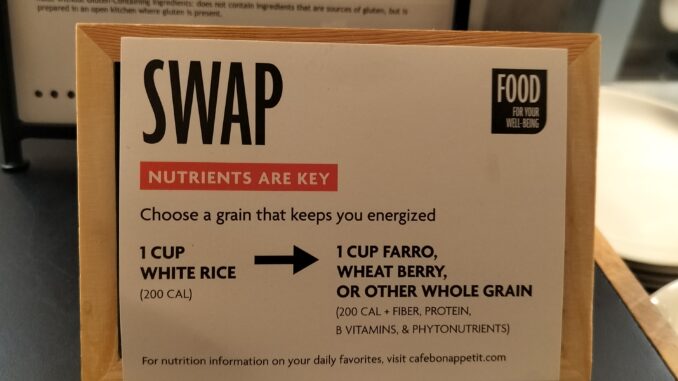
Imagine me, fresh-faced and nubile, walking into the Bon last Monday on a mission to eat well. I am a proud young woman with a voracious appetite, so a dinner surrounded by my friends is always a welcome relief from the stress of school.
Now imagine my utter dismay at seeing the new signs adorning the Bon: “Small Changes Add Up. Balance and portions count,” one reads. “Swap Beef Burger on White Bun (370 cal) (for) Black Bean Burger on Whole Wheat Bun (340 cal + 5g Fiber & Phytonutrients),” says another.
It was not that these signs offended me or that they were placed with any ill intent; healthy eating is not an inherently harmful practice to encourage, especially within the context of undergraduate programming at LC. Furthermore, these signs are from the Bon Appétit catering organization, which cannot account for the limitations of our humble dining service.
The unintended consequences of these seemingly harmless signs have me questioning their impact on our community. Last Monday, the Bon felt different — an unwelcome intrusion into the simple pleasure of communal dining.
The intentions behind these signs are commendable. Encouraging students to make healthier choices and promoting awareness about nutrition can be seen as positive. After all: knowledge is power, especially when it comes to making informed decisions about our diet. However, good intentions do not always translate seamlessly into positive outcomes.
The practical reality of the Bon’s offerings, or lack thereof, is where these signs’ messages begin to unravel. It is easy to suggest swapping white bread for a whole wheat alternative, but what if the Bon does not consistently offer the latter? The limited availability of certain items turns these well-meaning recommendations into a source of frustration for students seeking to follow the suggested changes.
Advocates might suggest that promoting alternative options, even if not always available, is a positive step. However, the key lies in recognizing the limitations of the Bon and ensuring that recommendations align with the practical realities of its offerings. Moreover, the scientific landscape surrounding nutrition is intricate and diverse.
Our bodies are not one-size-fits-all entities and a nuanced understanding of individual nutritional needs is crucial. While the signs advocate for a reduction in calorie intake, they fail to consider the varied nutritional requirements of a diverse student body. Scientific evidence supports the idea that rigid calorie counting and restrictive eating may not be universally beneficial and can contribute to unhealthy relationships with food (as was demonstrated by Levinson et al., 2017).
According to Johns Hopkins Medicine, the most common age of the onset of an eating disorder is between 12-25. With this in mind, the Bon must consider that it serves the age group most vulnerable to eating disorders. The allure of restrictive eating practices can be especially enticing in an environment where societal pressures often converge with personal insecurities. The unintentional consequence of these signs is the potential exacerbation of unhealthy eating habits and the fostering of an environment that may contribute to the development of eating disorders among vulnerable individuals. It is crucial to recognize that stress and trauma can manifest in various ways, and for some, controlling their food intake becomes a coping mechanism.
This is not an issue isolated to the realm of nutrition; it intertwines with mental and emotional health. Racial minorities and LGBTQ+ individuals, who may already grapple with unique stressors, are particularly vulnerable, according to the National Eating Disorders Association. The unintentional message conveyed by these signs can inadvertently exacerbate these challenges for these groups.
The inadvertent consequences of the calorie restriction signs in the Bon extend beyond a mere suggestion to make healthier choices. They touch on the complex dynamics of individual dietary needs, mental health and the vulnerability of certain groups on campus. As a community, we must collectively consider the impact of seemingly innocuous messages on the welfare of our peers.
The road to promoting a healthier campus environment involves a more nuanced approach — one that acknowledges the diverse nutritional needs of our student body’s student bodies, respects the limitations of our dining services and fosters a supportive atmosphere that prioritizes well-being over rigid dietary guidelines.
It is time for us to engage in a meaningful dialogue about how we can encourage healthier habits without inadvertently contributing to the challenges some students already face.
As of Monday, Jan. 29, the Bon has removed these signs from the buffet area. However, their impact calls into question the ways in which we promote healthy eating without encouraging problematic behaviors.
This stint serves as a learning opportunity. It is up to us to break the cycles of disordered eating entrenched in our society and work towards equitable healthy eating education that is rooted in awareness.
We only have one dining hall, it might as well serve us with cognizance.
Subscribe to the Mossy Log Newsletter
Stay up to date with the goings-on at Lewis & Clark! Get the top stories or your favorite section delivered to your inbox whenever we release a new issue.

Leave a Reply